Fourth Quarter 2019: Real Estate Market Report – New York Overview
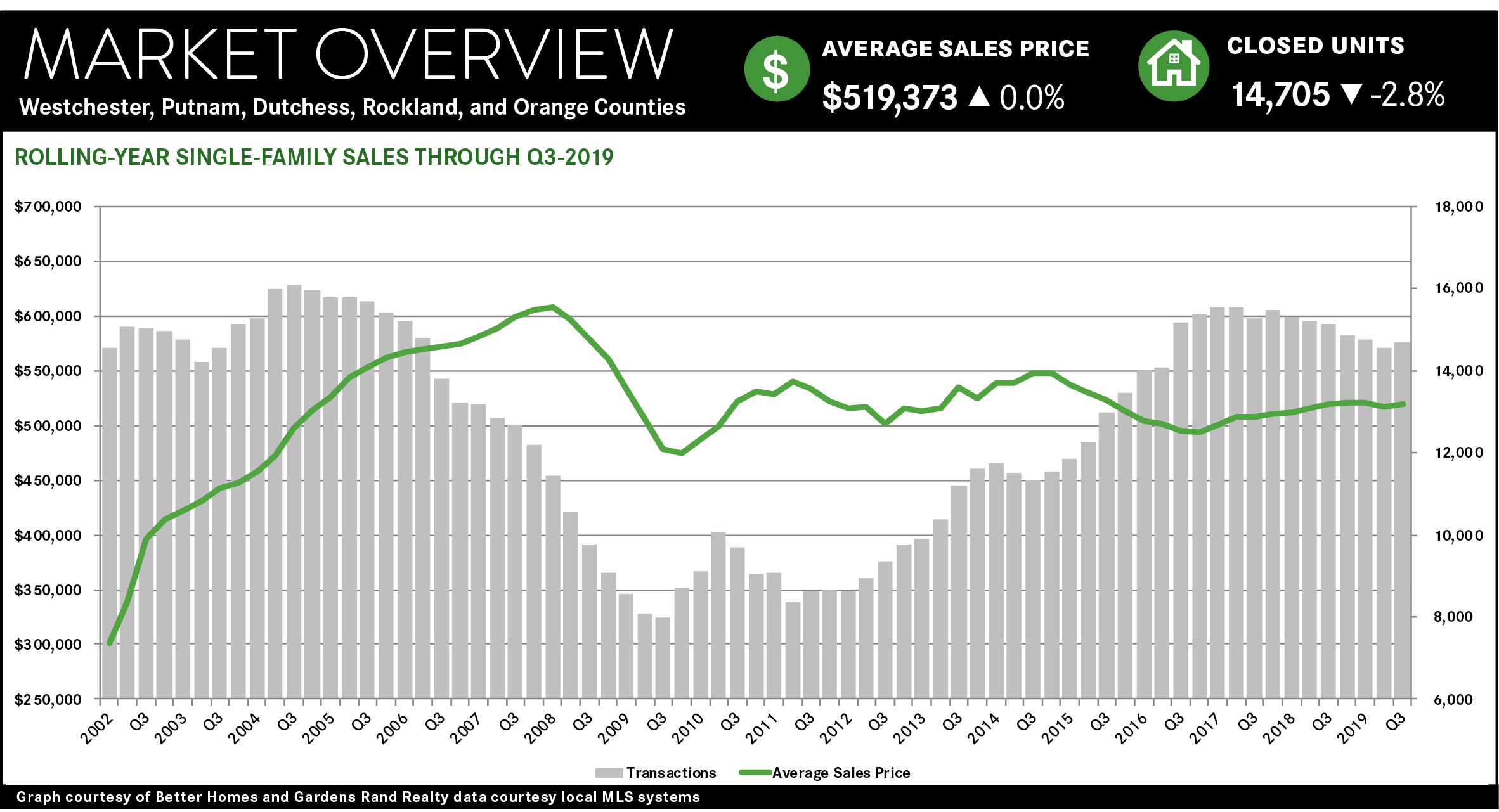
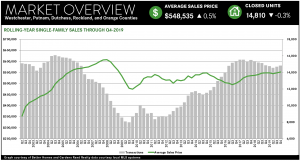
The housing market in Westchester and the Hudson Valley closed the year with a flourish, with regional sales and prices up modestly but meaningfully. The market overall continued to show signs of recovery from the suppressive effects of the 2018 Tax Reform’s Cap on State and Local Taxes (i.e., the “SALT Cap”). Although we are still seeing more demand in the lower-priced than upper-priced markets, the overall trend suggests continued growth in 2020.
Single-family sales were up regionally and in most of the individual counties. Regional sales rose 2.8%, only the second quarterly increase since the end of 2017 and the inception of the SALT Cap. For the 2019 calendar year, sales were down just a tick, but they picked up steam in the third and fourth quarter, after a weak start to the year. Within the individual counties, quarterly sales were mixed, tending to rise more in the higher-priced counties. Why? Because they were the hardest hit in 2018 by the inception of the SALT Cap, so their 2018 baseline numbers were suppressed more than in the lower-priced counties. As the SALT Cap continues to get priced into the market, we expect that sales will rise throughout the region in the spring.
Similarly, single-family prices were generally up across the region, reflecting some rising strength in the high-end. Regionally, the average price rose 2.8% from last year’s fourth quarter, following a similar increase in the third quarter. Most importantly, Westchester seemed to be recovering from the impact of the SALT Cap, with average prices up almost 3% for the quarter. Indeed, we might be seeing a long-awaited recovery in the high-end Westchester market: sales of super-luxury $3M+ homes rose 37% from last year’s fourth quarter. Westchester pricing tends to drive the rest of the market, so this was a welcome increase for all regional homeowners and sellers.
Inventory was still low, but rising. The lack of inventory throughout the region has held back sales growth, with most counties and property types well below the six-months of inventory level that signifies a balanced market. Inventory was still relatively low as the year ended but was trending up in just about every county market and property type. It might be that sellers are seeing prices go up, and are getting tempted into the market.
Going forward, we believe that the market is poised for a relatively robust 2020. Housing fundamentals are all positive: prices are still at attractive levels compared to the last seller’s market, interest rates are back down to historic lows, the economy is solid, and inventory might be loosening up. Accordingly, we believe that demand will continue to grow and that as the lingering effects of the SALT Cap dissipate, we will see more widespread price appreciation going into the spring market.
Fourth Quarter 2019: Real Estate Market Report – Westchester County, New York
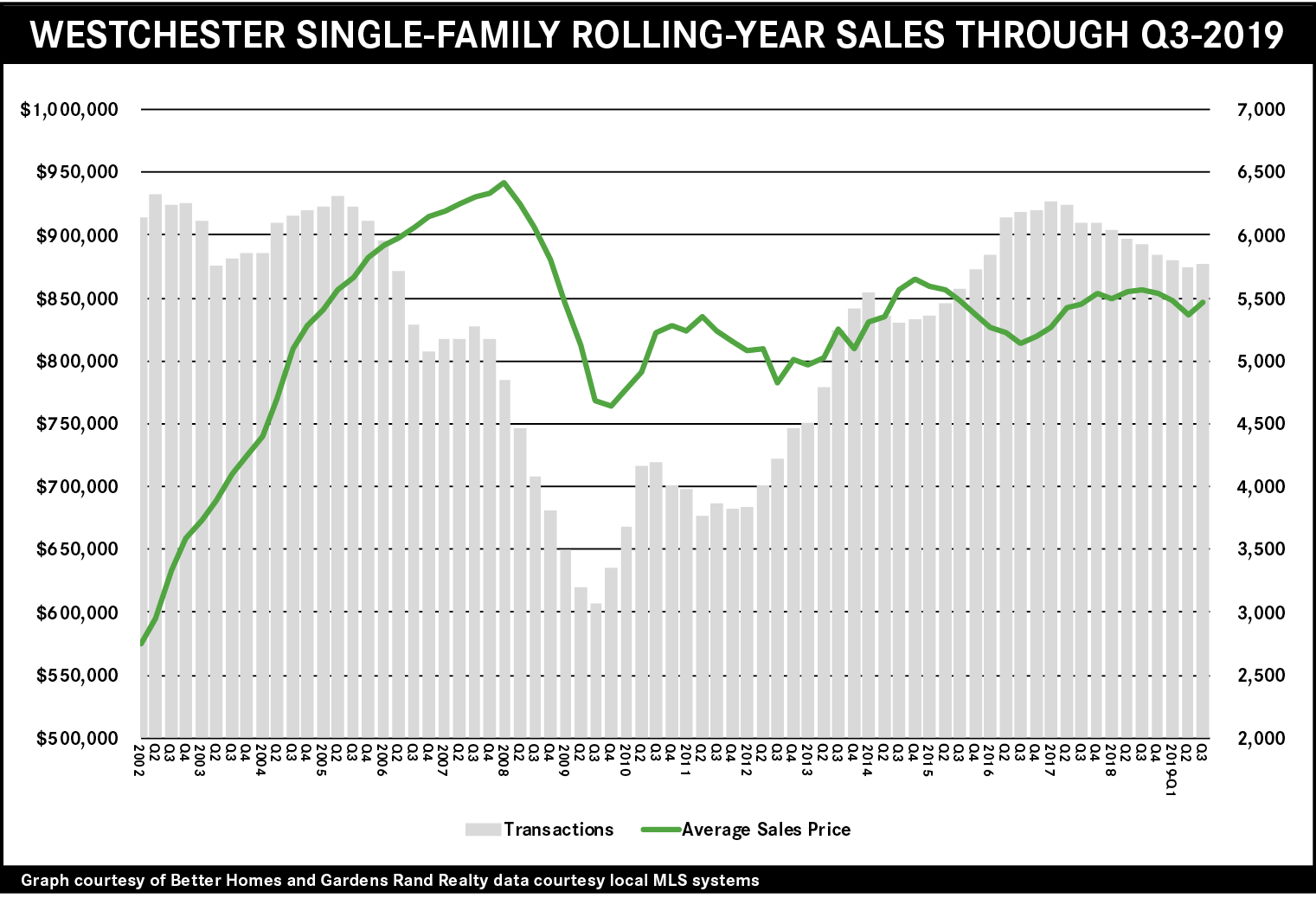
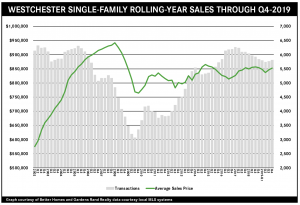
In the fourth quarter of 2019, the Westchester housing market continued to recover from the impact of the 2018 Tax Reform cap on state and local taxes (i.e., the “SALT Cap”). Single-family home sales were up almost 4%, the second quarterly increase in a row following seven straight declines after the SALT Cap went into effect. And prices were up as well, rising almost 3% on average and over 2% at the median. For the calendar year, Westchester’s single-family home sales and prices were mostly flat, due to the weak first half to the year. But the trend does seem to show that Westchester buyers are pricing in the SALT Cap after 18 months of doldrums – indeed, the high-end is well into recovery, with sales of $3M-plus homes rising 37% from last year’s fourth quarter. Going forward, we believe that Westchester will experience a robust spring market, responding to strong housing fundamentals like low-interest rates, a growing economy, and pricing still below the heights of the last seller’s market.
Fourth Quarter 2019: Real Estate Market Report – Rockland County, New York
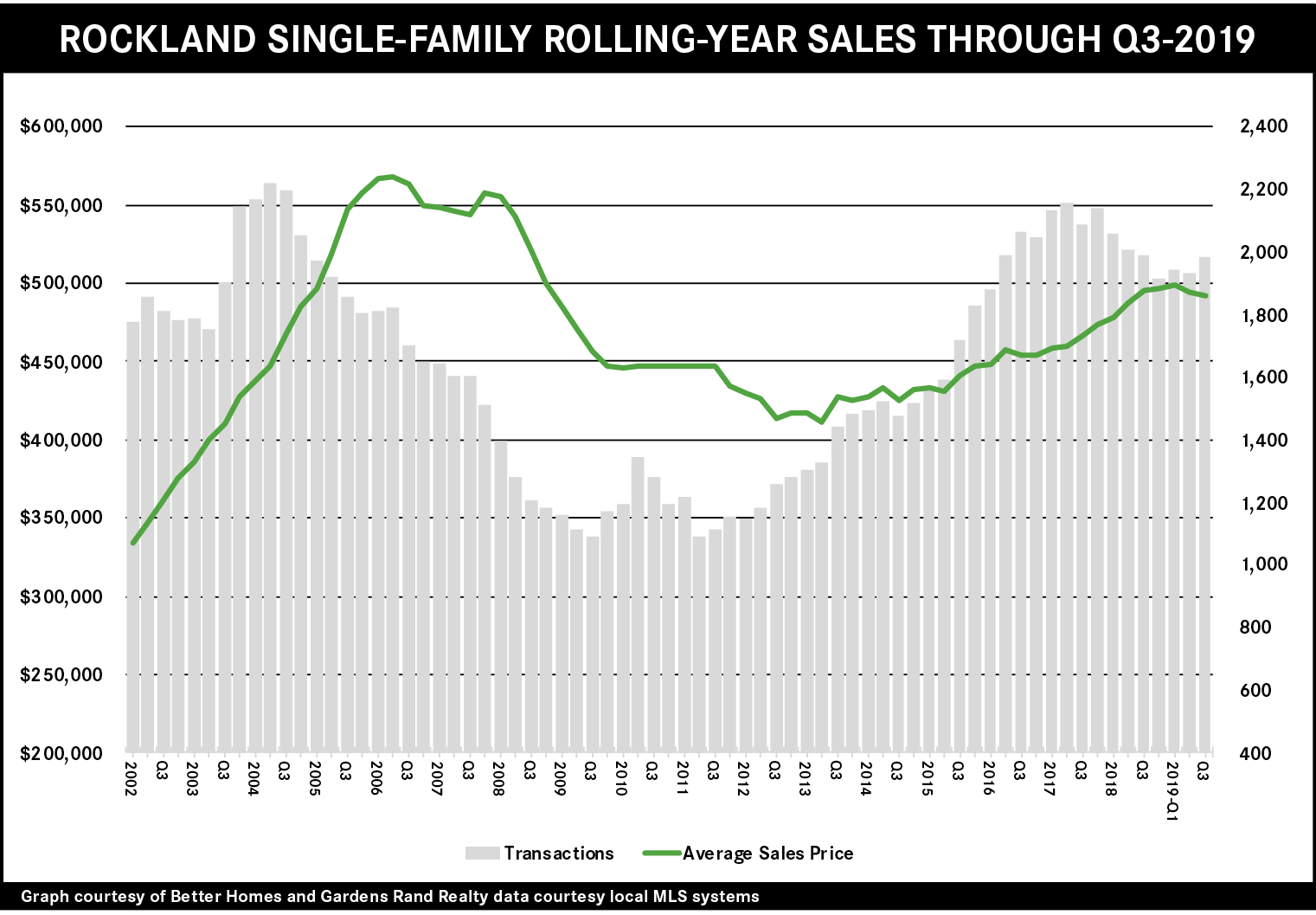
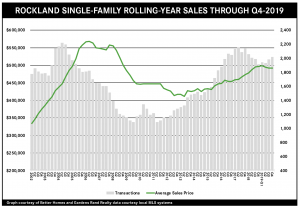
Activity in the Rockland housing market surged in the fourth quarter of 2019, even while the 2018 Tax Reform cap on state and local taxes (i.e., the “SALT Cap”) continued to suppress pricing growth. Single-family transactions rose over 7% for the quarter, and almost 6% for the full calendar year, reflecting high levels of demand spurred by strong economic fundamentals. But the SALT Cap has suppressed demand in the higher-ends of the market, which has held back pricing for single-family homes overall. In contrast, 2019 full-year prices in the lower-priced condo market were up over 8% on average and 10% at the median, because buyers at those price points generally don’t itemize their taxes and are mostly unaffected by the SALT Cap. Going forward, we do believe that the SALT Cap will ultimately get priced into the market and that the strong housing fundamentals will drive a relatively robust spring market.
Fourth Quarter 2019: Real Estate Market Report – Orange County, New York
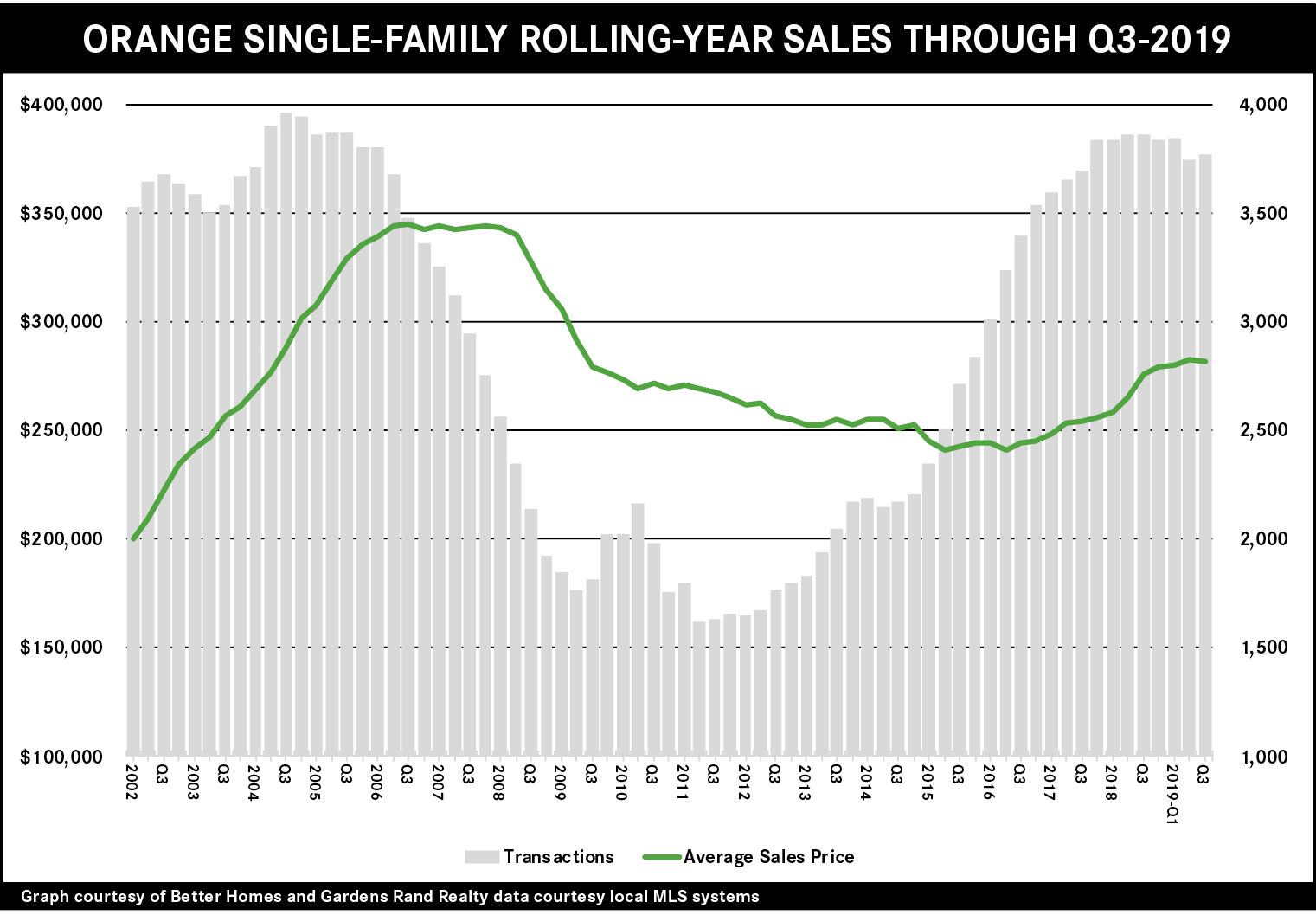
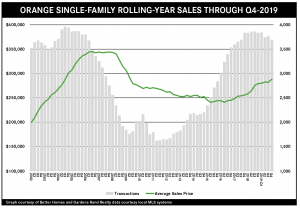
Pricing in the Orange County housing market surged in the fourth quarter of 2019, even while low levels of inventory continued to stifle sales growth. Pricing was up across the board, with single-family home prices rising over 8% on average and almost 9% at the median compared to last year’s fourth quarter. And for the full 2019 year, single-family prices were up 3% on average and almost 5% in the median. Condo prices were also generally up, rising 5% on average and over 6% at the median for the year, even while the quarterly numbers were mixed. We note that sales activity for both single-family and condo homes was down for the quarter, but that was largely based on a lack of inventory rather than a slackening of demand. Orange inventory is way down, finishing the year with under five months of inventory for single-family homes and an unprecedented two months for condos. Going forward, we think that rising prices will tempt more sellers into the spring market, and that buyer demand will stay strong with rates low and the economy growing.
Fourth Quarter 2019: Real Estate Market Report – Dutchess County, New York
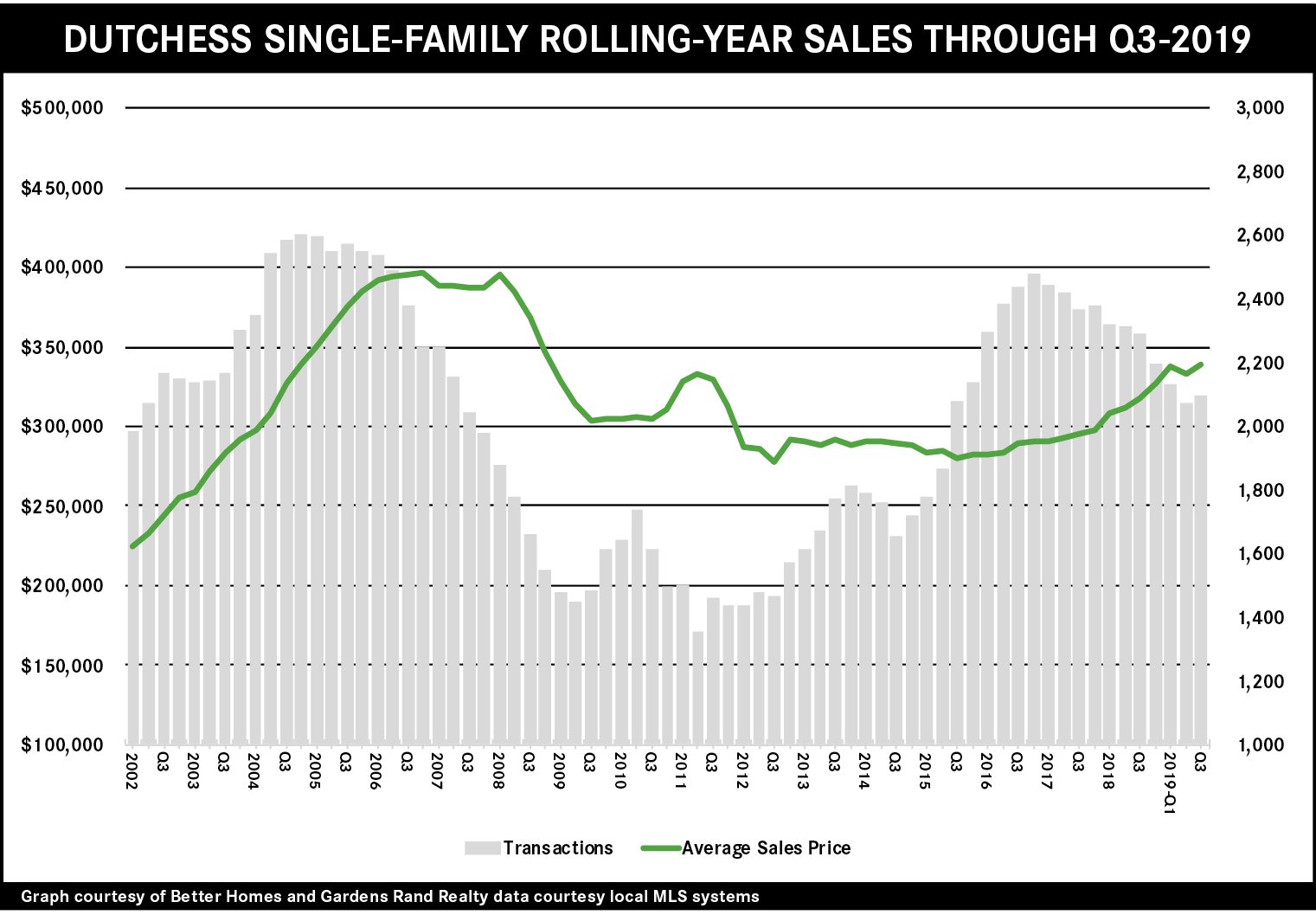
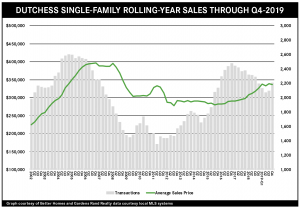
The Dutchess county housing market surged again in the fourth quarter of 2019, closing a robust 2019 with a flourish. Sales activity was way up, with single-family home sales up almost 20% from last year’s fourth quarter, which made up for a lackluster start to 2019 – as you can see, even with the fourth-quarter surge, sales for the full year were basically flat. Quarterly sales were also up almost 13% for condos, finishing the year up almost 7%. Pricing for the quarter was a bit more mixed: single-family homes were down about 3% on average but up almost 4% at the median, while condos were up about 5% on both the average and the median. But for the year, pricing was up meaningfully, with single-family homes up almost 3% on average and over 4% at the median, and condos up over 4% on average and almost 3% at the median. Going forward, we believe that Dutchess is entering 2020 in good shape, and the strong economic fundamentals will drive a relatively robust spring market.
Fourth Quarter 2019: Real Estate Market Report – Putnam County, New York
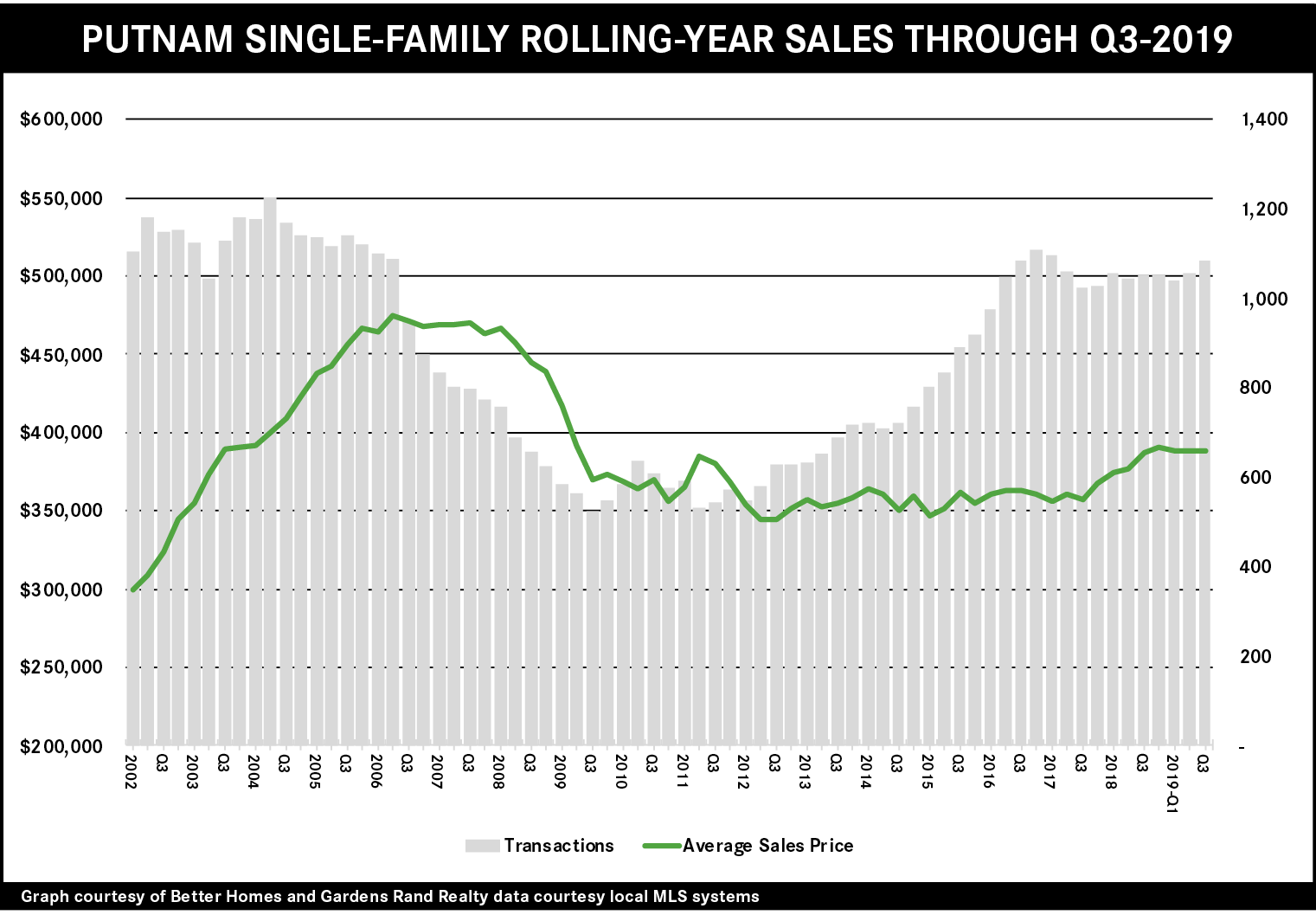
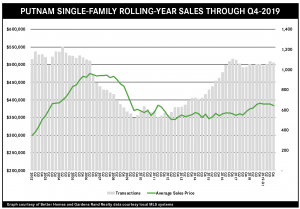
The Putnam housing market corrected a bit in a slow fourth quarter, after surges through much of the year. Single-family home sales were down about 3% for the quarter, with prices falling over 4% on average and almost 7% at the median. For the 2019 calendar year, though, Putnam’s market generally grew, with sales up over 2% from 2018. Full-year prices were more mixed, with the average falling almost 2% and the median rising almost 3%. We believe that this pricing divergence is mostly due to the effects of the 2018 Tax Reform cap on state and local taxes (i.e., the “SALT Cap”), which has had more of an impact on the average price by suppressing some high-end activity. Going forward, we expect a relatively robust spring market, with prices still below their seller-market highs, interest rates near historic lows, and a growing economy.
Fourth Quarter 2019: Real Estate Market Report – Bronx County, New York
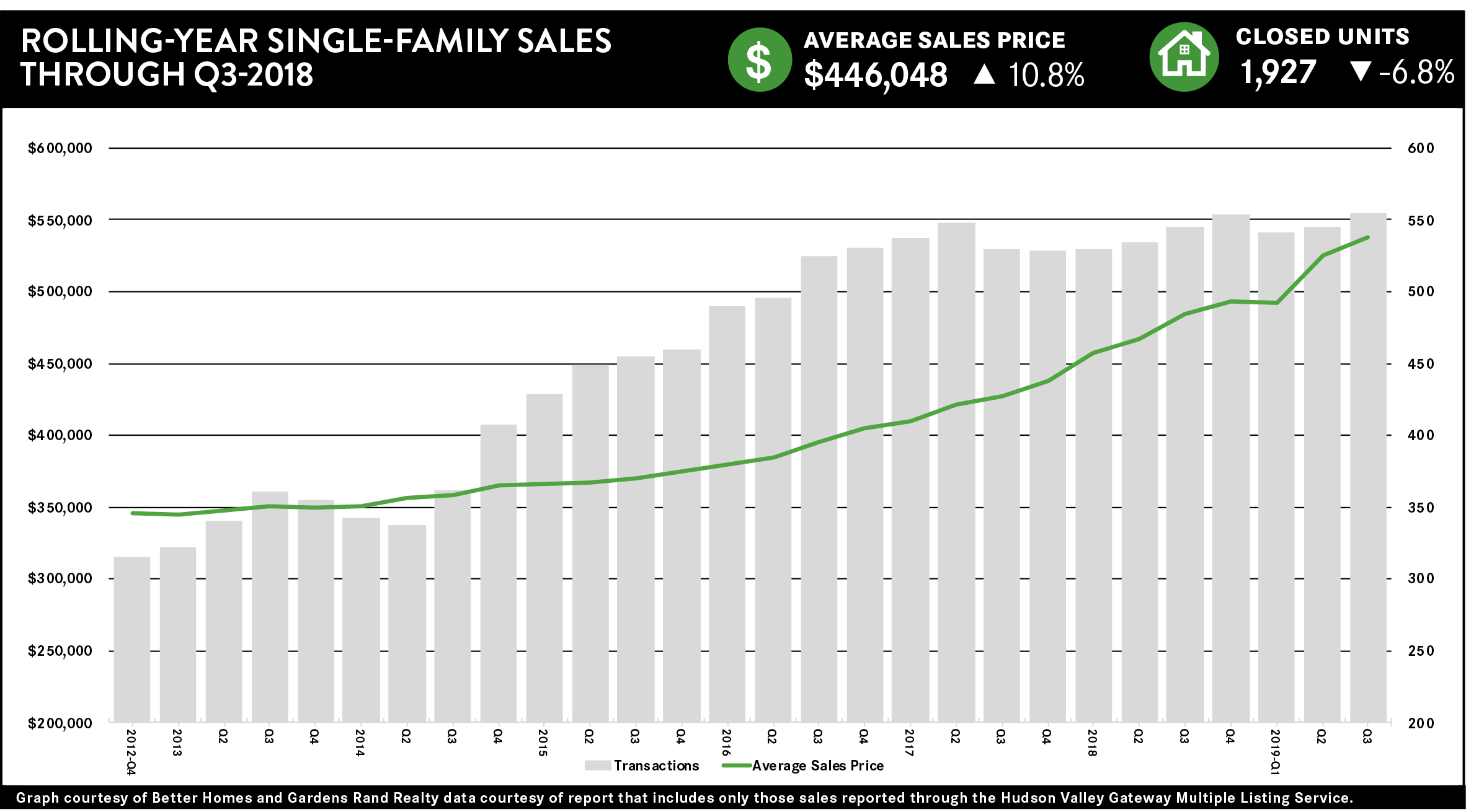
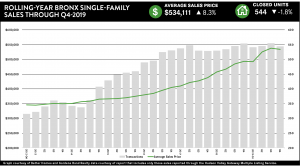
The Bronx housing market slowed down just a bit in the fourth quarter of 2019, with sales falling slightly and prices topping out after a robust run-up for most of the year. We believe that, like other high-priced markets throughout the region, the Bronx might be feeling the impact of the 2018 Tax Reform’s Cap on State and Local Taxes (i.e., the “SALT Cap”), particularly in the higher end of the market. Even with the suppressive effects of the SALT Cap, though, we believe that the housing fundamentals are strong, and expect a relatively robust 2020.
Pricing. Overall pricing was down slightly compared to the fourth quarter of last year, falling more than 1%. The individual property types were mixed: average prices were down 3% for single-family homes, up almost 2% for multi-families, down 2% for coops, and down 20% for condos. We caution not to read too much into the condo number since the Bronx condo market is a relatively thin slice of data. For the year, though, pricing was up 5% overall, and up for all property types other than condos.
Sales. Sales were down slightly, falling over 2% from last year’s fourth quarter and finishing the year down almost 6%. Previously, we have attributed slow sales to a lack of inventory, which has stifled sales growth by denying the Bronx enough “fuel for the fire.” But the Bronx market might also be hurt by the SALT Cap, which particularly impacts buyers in higher price ranges, who are more likely to itemize their taxes. And while some micro-markets in the Bronx are probably not affected, we note that the average price overall in the borough is about $500,000, which is about where home buyers are more likely to feel the pinch of the SALT Cap limitations on property and state income tax deductibility.
Inventory. Inventory was generally up, rising for all property types and down only slightly for condos. Inventory is still in the 5-6 month range for most property types, a level that usually indicates a seller’s market, but it’s definitely opening up a bit. That might start to push sales up in 2020.
Outlook. Going forward, we believe that Bronx sellers and homeowners continue to have reason to be optimistic about where the market is going. The fundamentals are very strong: the economy is growing, inventory is still low, interest rates are near historic lows, and demand is strong. We expect that even with the challenges of a slowdown in Manhattan and the pinch of the SALT Cap, the Bronx market will continue to see price appreciation and sales growth through the winter and the spring markets.
Fourth Quarter 2019: Real Estate Market Report – Northern New Jersey
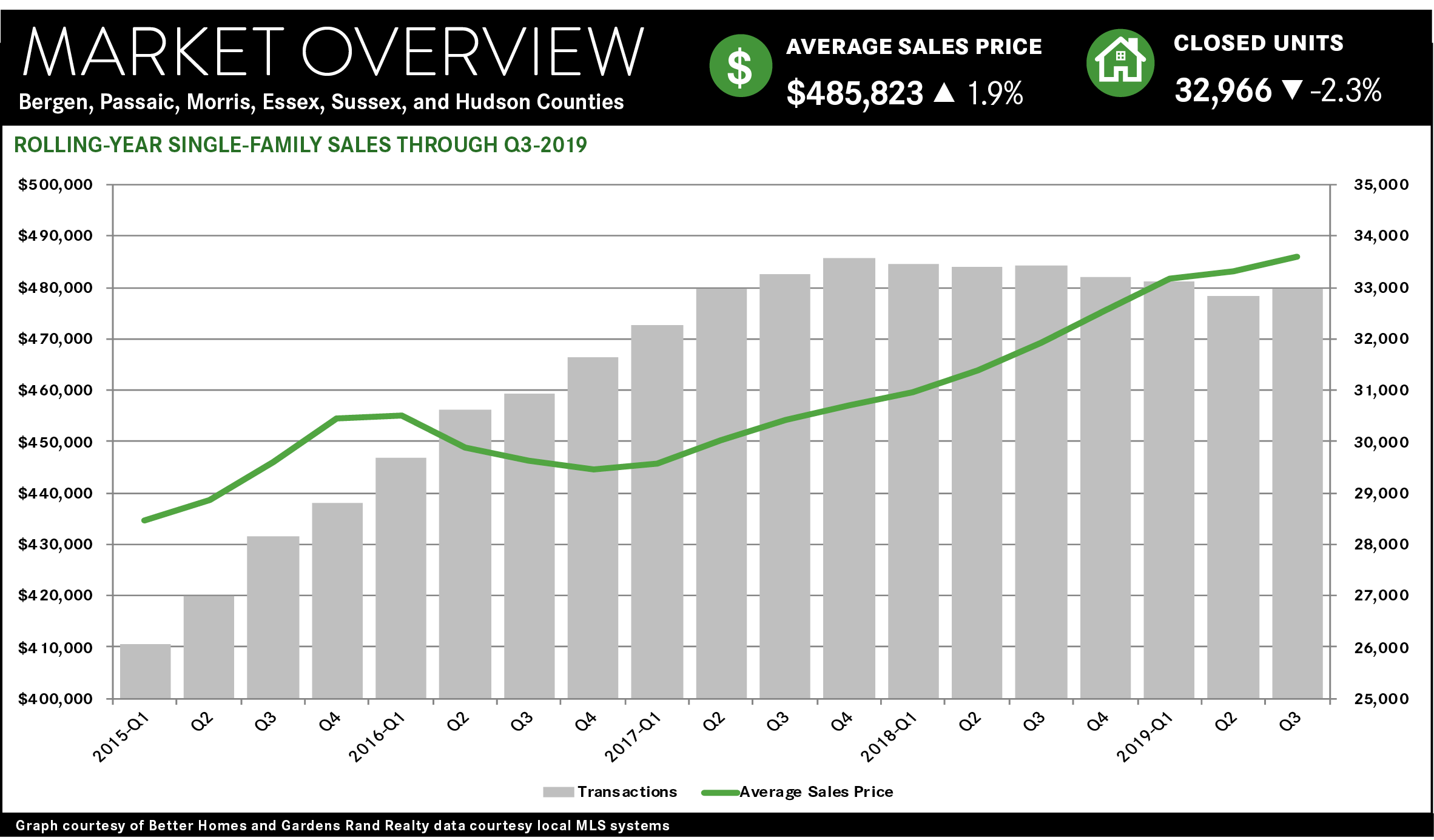
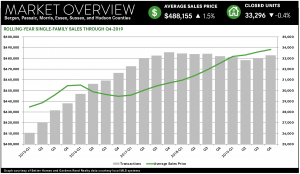
The Northern New Jersey housing market finished 2019 with a bit of a flourish, with sales and price increases in most of the county markets. We are still seeing some negative impact from the 2018 Tax Reform cap on state and local tax deductions (i.e., the “SALT Cap”), but outside of Hudson County, most of the suburban markets seem to be pricing in the partial loss of property tax deductibility. Going forward, we believe that strong housing fundamentals will continue to drive meaningful price appreciation and sales growth through a robust 2020.
Sales rose for the region and in most individual counties. Regional single-family sales rose 2.4% for the quarter, reversing a downward trend we had seen for most of the year. And the increase was pretty uniform throughout the region, with sales up in every almost every individual county. The exception was Hudson, which has been particularly impacted by both the SALT Cap and the decline in the Manhattan market resulting from the SALT Cap. Generally, the SALT Cap has suppressed buyer demand at the very highest end of the market, where home buyers who itemize their deductions are more likely to feel the pinch. This is hampering sales in the higher-end segments of every market, and thereby dampening average price appreciation, but the impact seems to be dissipating a bit outside of Hudson.
Prices were also up for the region and in most of the markets. For the region, the average price was up 2.1% for the fourth quarter and finished the year up 1.5%. Again, the trend was pretty uniform across the region, with average prices rising in every county outside of Hudson. We are now seeing pricing approaching higher levels than at any time since the height of the last seller’s market in the middle of the 2000-10 decade.
We still believe that this market is poised for significant growth. Inventory remains near or below the six-month level that usually denotes a seller’s market, but we expect that more homes will come on the market as prices increase. And the SALT Cap continues to have a suppressive effect in the high end, but will eventually get priced into the market and open up the high end a little more.
Going forward, we expect a rising market in 2020. The seller market fundamentals are very strong: the economy is growing, interest rates are near historic lows, inventory is relatively low, and homes are still priced below their last seller market highs. Accordingly, we expect that sales and prices will show some modest strength through the rest of the winter, leading into a traditionally robust spring market.
Fourth Quarter 2019: Real Estate Market Report – Sussex County, New Jersey

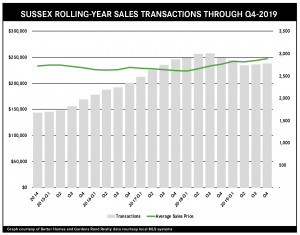
The Sussex County housing market showed continued signs of strength in the fourth quarter of 2019, with sharp increases in both sales and prices. Sales were up almost 3%, which continued a trend from the third quarter and helped moderate the significant sales declines in the early part of the year – sales were down almost 5% for the calendar year, but they were down much more sharply in the first six months. More significantly, we’re starting to see sustained strength in pricing: for the quarter, prices were up almost 7% on average and 8% at the median, finishing the calendar year up almost 5% on average and over 9% at the median. Indeed, the average price in Sussex is now higher than at any point since the height of the last seller’s market in the middle of the 2000s. Going forward, we believe that the seller market fundamentals are strong: a growing economy, prices well below historic highs, low-interest rates, and relatively low levels of inventory. So we expect to see continued appreciation and sales growth through 2020.
Fourth Quarter 2019: Real Estate Market Report – Essex County, New Jersey
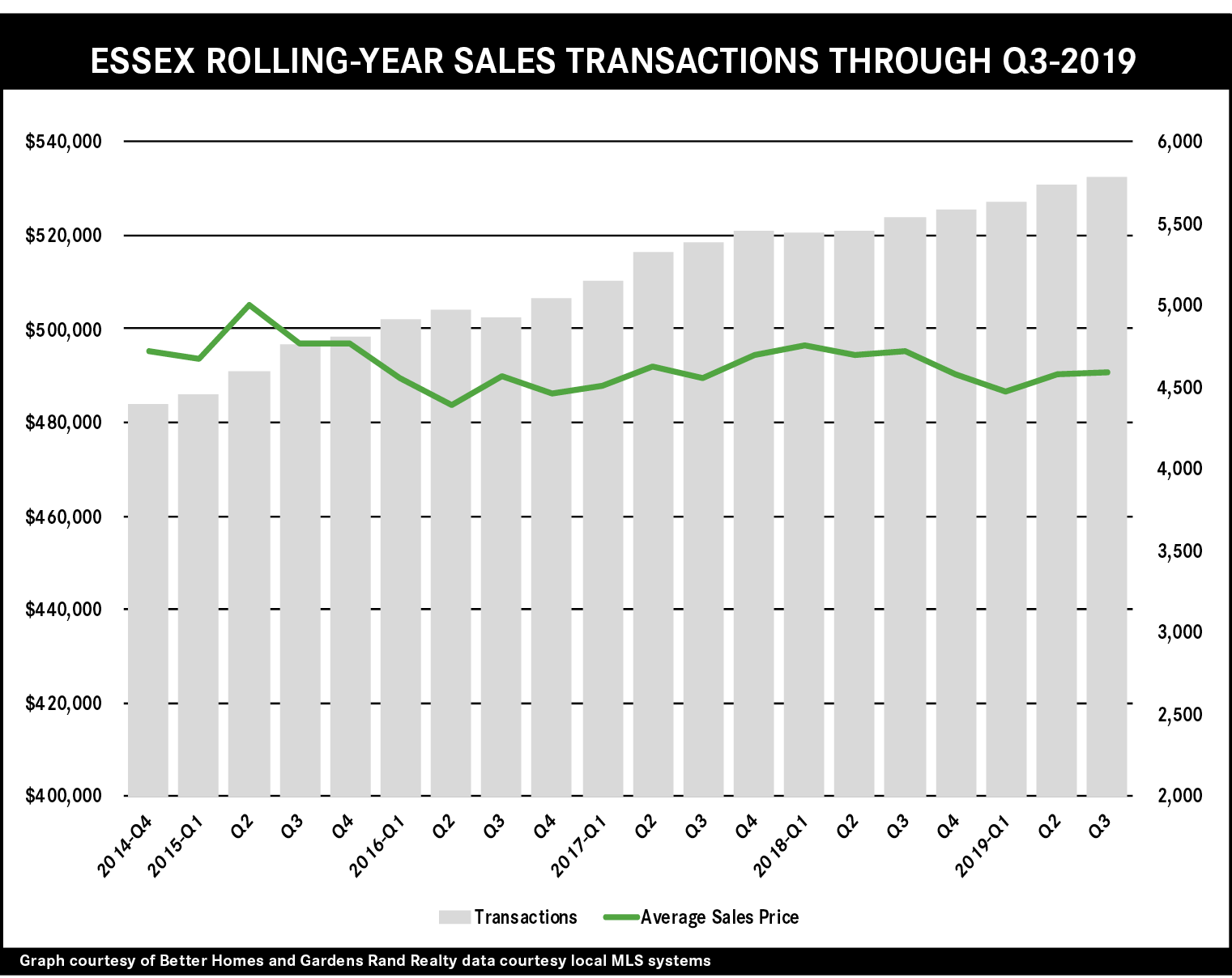
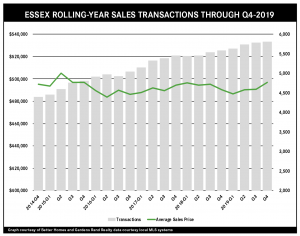
The Essex County housing market finished a strong year with a flourish, with increases in both sales and prices. Sales rose almost 2% for the quarter and finished the 2019 calendar year up almost 4%. And these continued increases in sales are finally having a meaningful impact on pricing, which was up for both the quarter and the year: prices were up 6% on average and almost 4% at the median for the quarter, and were up about 1.4% on both the average and median for the year. Going forward, we believe that the seller market fundamentals are strong: a growing economy, prices well below historic highs, low-interest rates, and low levels of inventory. Accordingly, we expect meaningful sales growth and appreciation through 2020.

 Facebook
Facebook
 X
X
 Pinterest
Pinterest
 Copy Link
Copy Link



